
President Trump refuses to acknowledge that Russia hacked the 2016 election. Republicans are too politically afraid of him and Democrats are too focused on obstructing him to make him accept it. This means he nor the Senate or Congress will likely do nothing to guarantee secure elections in 2020. Fortunately, a ray of hope has emerged from the west coast that will be used for the first time in 2020 to secure elections in America’s largest voting district, providing an example of how all of America’s voting districts can be made hack-free.

It is a fact that Russia interfered with the 2016 election and they are gearing up to do the same thing in the 2020 elections
Los Angeles County, with its 5.2 million registered voters has more registered voters than 42 states making it the largest voting district in America. Realizing secure elections were not possible with a voting system that was using outdated and discontinued technology vulnerable to cyber-hacking, Los Angeles County decided to design and build its own voting system. The most important aspect of voting that the new system delivers is a complete overhaul of the voting machine.
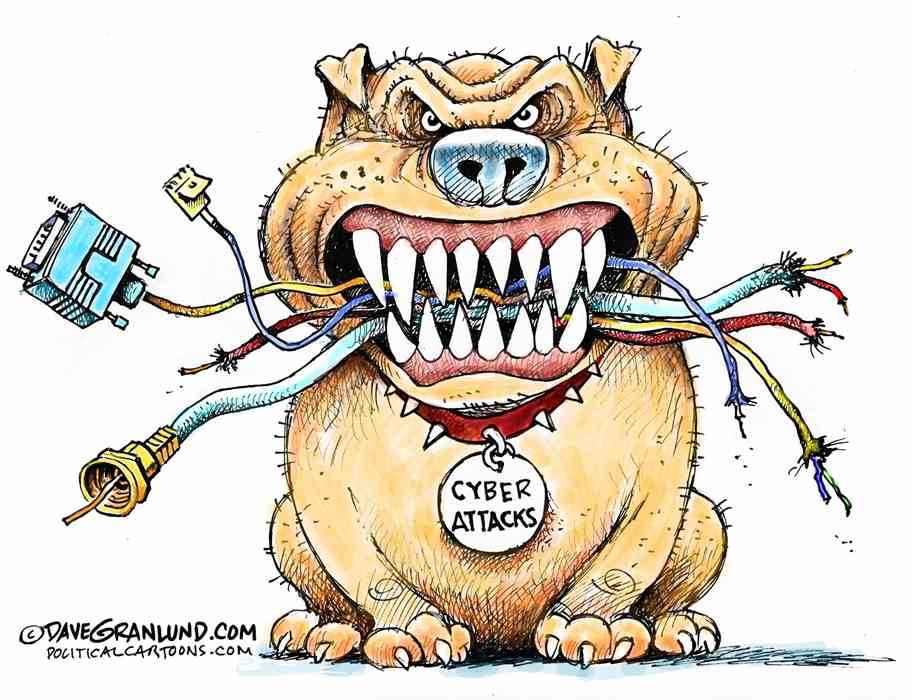
All election systems in America are currently vulnerable to cyber hacking
Los Angeles County is not the only voting district who can’t guarantee secure elections due to the use of outdated or discontinued voting technology. A study by the Brennan Center for Justice shows that 38 states use discontinued voting machines that are no longer manufactured in one or more voting districts, and another seven states use voting machines that have been discontinued in all their voting districts. Most states can’t guarantee secure elections because they are using voting systems developed after the disputed 2000 hanging chad election. As Greg Miller, cofounder of Open Source Election Technology, a nonprofit that conducts election technology research, said “You have equipment that was introduced in 2005, in that time frame, how many times have you changed your mobile phone? And how many times have we replaced our laptops?”
Click below to see why America has to install the same type of new voting system as the one Los Angeles County will debut in the 2020 elections Using voting machines with outdated or bug plagued software with no paper back-up of the votes cast can cause confusion and distrust in the vote totals. This has been the case in the state of Texas for at least a decade. The problem involves eSlate direct recording electronic (DRE) voting machines made by Hart InterCivic. During the 2018 election, Texas straight-ticket voters reported that the eSlate voting machines recorded them selecting the wrong candidate of another party, or left their vote for U.S. Senate blank.
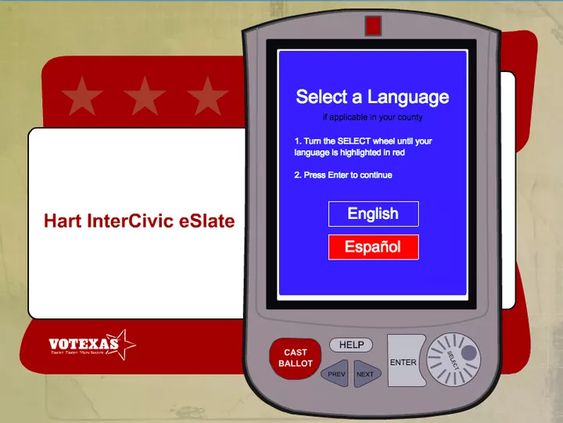
The eSlates, electronic voting system has a software glitch that for the last 10 years has likely caused some Texas voters to vote for candidates that they did not intend to vote for, it also has no paper ballot back-up to audit or verify votes that were cast. Texas says they can’t afford the software fix to remove the glitch
According to the Texas Secretary of State’s office “The Hart eSlate machines are not malfunctioning, the problems being reported are a result of user error, usually, voters hitting a button or using the selection wheel before the screen is finished rendering.” But in a 2017 paper, two researchers at Rice University examined the usability of Hart’s eSlate devices, their research cites a 2008 study of 1500 voters that ranked the Hart eSlate the lowest for ease of use out of six commonly used electronic voting systems.
🚨 ALERT: We have received multiple reports from voters who voted straight-ticket, then saw on a later screen that their votes were changed to that of the opposite party. You must check your ballot before casting to ensure it’s correct, and you can ask a poll worker for help.
— Texas Civil Rights Project (@TXCivilRights) October 25, 2018
There is evidence, both anecdotal and experimental, suggesting that the eSlate is not particularly usable,” the paper’s authors wrote. “Counties are already spending a great deal of money on the eSlate and using the systems in elections despite potential usability issues that could lead to longer voter times… and mistakes made by voters while making selections on ballots.” Aside from these problems eSlate like most electronic voting systems provides no paper back-up of the votes it records.

Thanks to President Trump’s refusal to face the fact that Russia hacked the 2016 election this could be the reality for the 2020 elections
A common misconception about American voting systems is that they provide secure elections because the voting machines are not connected to the internet or to each other. The belief is that the votes they record are always accurate because the machine is isolated without the possibility of an external force to hack it. Nothing could be further from the truth!!! Hackers don’t need to hack the voting machines to prevent secure elections because they can hack the computer networks that control the voting machines.
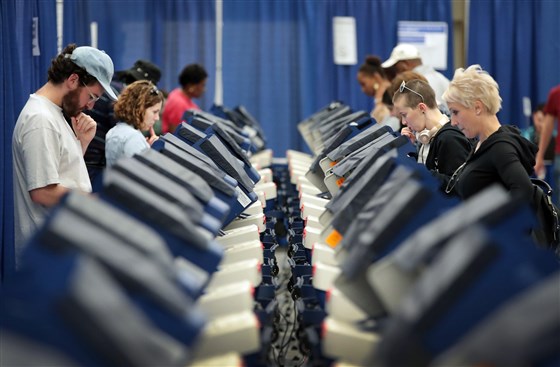
All of these Illinois citizens casting their votes are vulnerable to potential vote theft because Russian hackers successfully penetrated the Illinois State Board of Elections
Hackers infiltrate what is called election-management systems and leave a malicious code. These are election networks of computers operated by the state government, the county government, or an outside vendor that designs what’s on the ballot and the rules for counting the votes that are cast on the voting machines. Once this is done election officials copy the design and vote counting rules onto memory cards or USB sticks for insertion into the voting machines. This provides the route for the malicious code, implanted when hackers infiltrated the computer election network, along with the design and vote counting rules to spread from the computer election network to the many voting machines in the field. The malicious code runs on the individual voting machines as just another piece of software with access to all of the voting machine’s data and instructions on how to distort it.
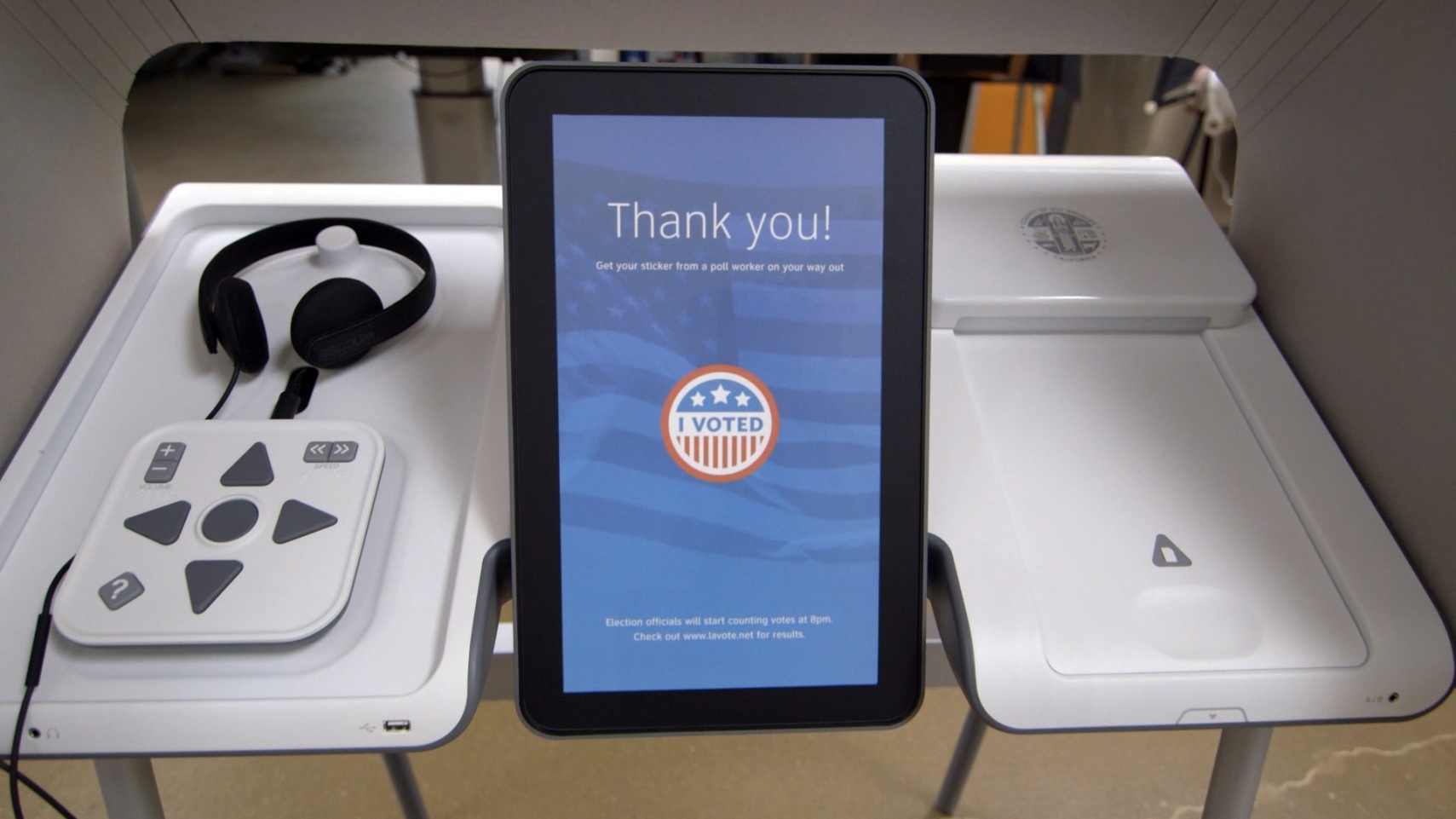
Los Angeles County’s new voting system features a touch screen (center) that allows voters to advance through different screens and cast votes in different races. The votes are also recorded on a paper ballot (right) serving as a written record for recounts and vote audits, earphones (top left) are provided for voters who would prefer to hear their vote choices instead of reading them
L.A. County’s new voting system, which will debut in the 2020 elections, does guarantee secure elections by doing away with the vulnerabilities of ALL the current voting systems. It was built with open-source technology available to everyone instead of patent technology owned by a corporation, so L.A. County will no longer have to depend on a vendor to keep producing security updates to protect the system from hacks. According to L.A. County Registrar Dean Logan, the machines are designed to be agile and interchangeable if a better part comes on the market components can be swapped out without scrapping the whole machine.
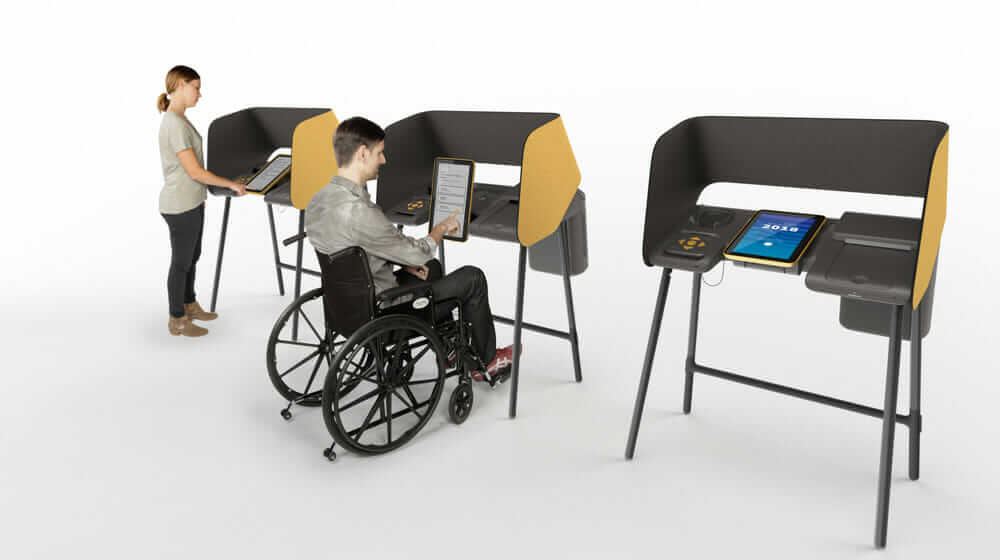
L.A. County’s new vote system has a touch screen that can be adjusted eliminating the need to designate separate voting booths for the physically challenged voters
The new L.A. voting system combines a paper ballot with a touch screen. Inside the voting booth, a person makes his or her choices on the screen. The voter then reviews the choices, feeds a paper ballot into the machine, and presses an on-screen button to complete the vote. The paper ballot then drops into a secure box, becoming the official record of the voter’s selections as recorded using the interface on the Ballot Marking Device. Official ballots are counted independently on a separate tally system after the polls close on Election Day. The system accommodates write-in votes, and will also allow a voter to fill out the paper ballot manually and then feed it into the machine if the person prefers. There are also 14 different languages available, large-type and earphone options, and a screen that can adjust for voters in wheelchairs.
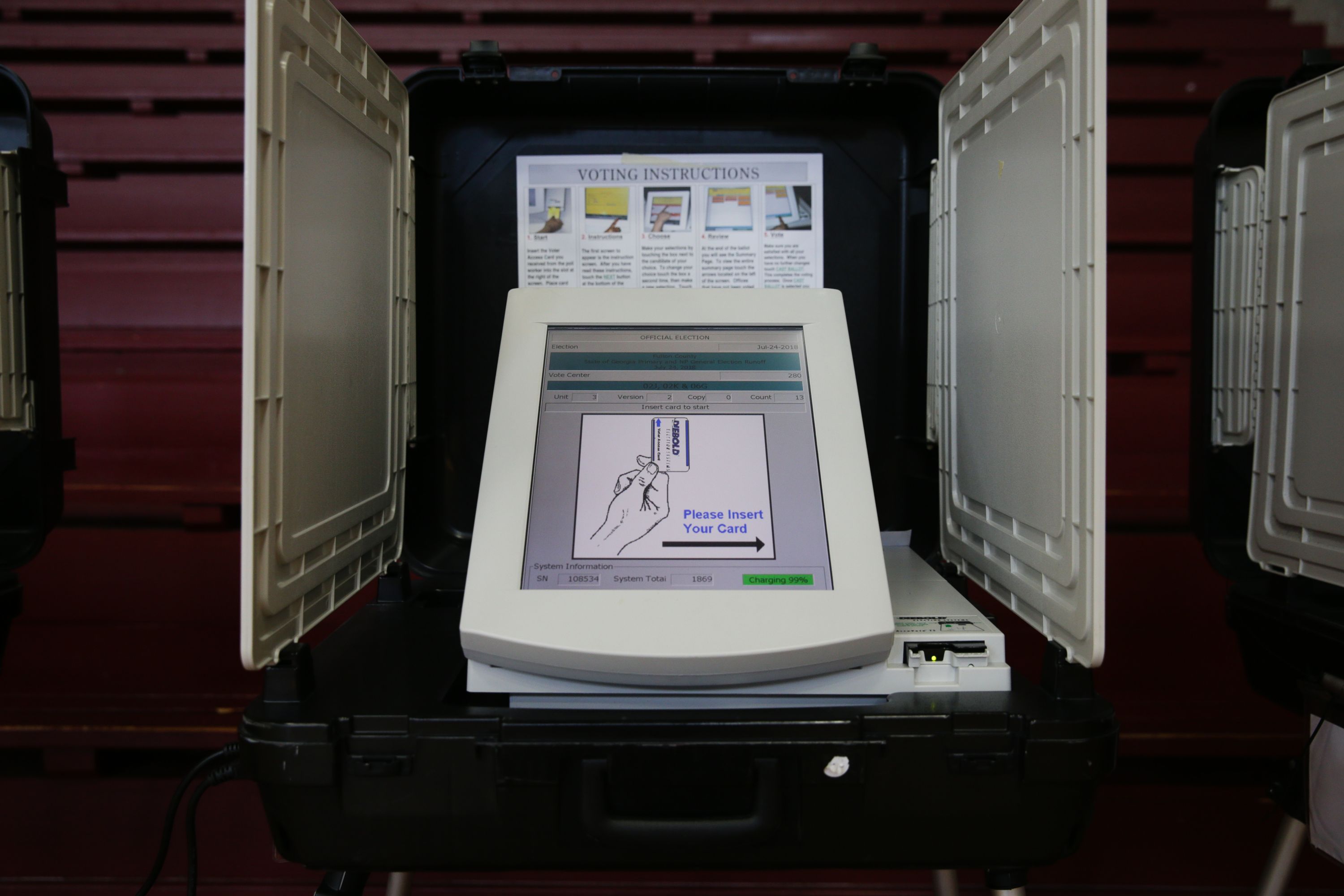
A Diebold Election Systems Inc. electronic voting machine sits in a privacy booth at a polling location during the 2018 Georgia primary runoff elections in Atlanta. Georgia is among 14 states using touchscreen, computerized machines that don’t meet federal security guidelines because they produce no paper record so voters can’t verify their choices and officials can’t audit the results. Photographer: Elijah Nouvelage/Bloomberg via Getty Images
L.A. County’s paper ballot back-up reverses a bad trend in America, currently there are about 14 states that have voting districts where ballots aren’t being recorded on paper, Georgia, for example, is paperless throughout the entire state and is using voting machines with software that hasn’t had a security update since 2005. The National Academies of Sciences, Engineering and Medicine released a report that urged all states to adopt paper ballots before 2020 so that proper post-election audits for accuracy of votes cast is possible. If no paper trail exists, then it’s impossible to perform a rigorous audit. All you can do is hit the print button again on a computer program getting the same result you got the first time, whether it is true or not.
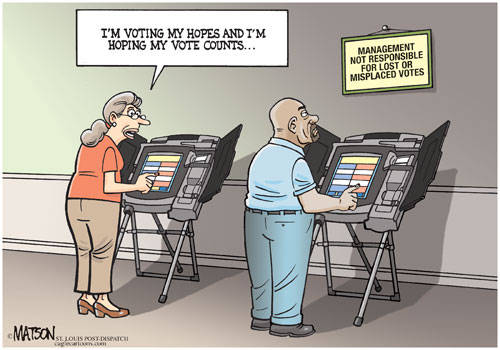
This is the future state of voting in America if President Trump, Republicans, and Democrats don’t take the steps to upgrade election systems in all of America’s voting districts
Los Angeles County, America’s largest voting district, has provided a ray of hope and America’s path to hack-free secure elections. Let’s hope and pray that President Trump, Republicans, and Democrats can stop focusing on the legitimacy of their personal elections long enough to follow L.A. County’s lead and focus on the legitimacy of all American elections, by providing the resources necessary to replace all hackable voting systems with new hack-free voting systems that are backed-up with paper ballots guaranteeing secure elections everywhere in America.
